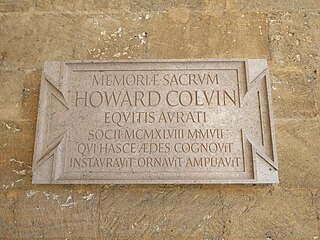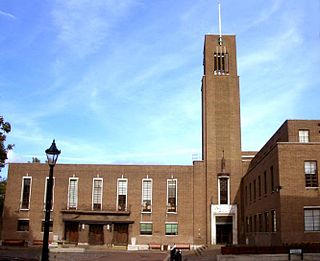Related Research Articles

William Butterfield was a British Gothic Revival architect and associated with the Oxford Movement. He is noted for his use of polychromy.
Sir John Newenham Summerson, was one of the leading British architectural historians of the 20th century.

The Survey of London is a research project to produce a comprehensive architectural survey of central London and its suburbs, or the area formerly administered by the London County Council. It was founded in 1894 by Charles Robert Ashbee, an Arts-and-Crafts designer, architect and social reformer and was motivated by a desire to record and preserve London's ancient monuments. The first volume was published in 1900, but the completion of the series remains far in the future.

Sir Howard Montagu Colvin was a British architectural historian who produced two of the most outstanding works of scholarship in his field: A Biographical Dictionary of British Architects, 1600–1840 and The History of the King's Works.
Joseph Clarke (1819–1888) was a British Gothic Revival architect who practised in London, England.
Edmund Kirby was an English architect. He was born in Liverpool, and educated at Oscott College in Birmingham. He was articled to E. W. Pugin in London, then became an assistant to John Douglas in Chester. He travelled abroad in France and Belgium, and had started to practice independently in Liverpool by 1867, initially having offices in Derby Buildings, Fenwick Street. Between 1880 and 1914, his offices were in Union Buildings, Cook Street, Liverpool. In 1905 Kirkby took his two sons, Francis Joseph and Edmund Bertram, into partnership. He retired in 1917, and died in 1920. His practice continued after his death, until it merged with Matthews and Goodman in 2011.
Joseph Stretch Crowther was an English architect who practised in Manchester. His buildings are mainly located in Manchester, Cheshire and Cumbria.
Francis Xavier Velarde OBE was an English architect who practised in Liverpool, Merseyside, England.
Bridget Cherry is a British architectural historian who was series editor of the Pevsner Architectural Guides from 1971 until 2002, and is the author or co-author of several volumes in the series.

Reginald Harold UrenFRIBA was a New Zealand-born architect who worked in the United Kingdom for most of his career.

Woolwich Town Hall is an early 20th-century town hall located in the historic Bathway Quarter in the centre of Woolwich, South East London. Until 1965 it was the seat of local government of the Metropolitan Borough of Woolwich, after which it became the headquarters of the Greenwich London Borough Council. It is a rare example of an Edwardian Baroque town hall in London and is a Grade II*-listed building.

The Croft is a large detached house on Totteridge Green in Totteridge, Barnet. It has been Grade II listed on the National Heritage List for England since November 1974.

Battersea Town Hall, originally the New Parochial Offices, Battersea, is a Grade II* listed municipal building in Battersea, south London, designed by Edward Mountford and erected between 1891 and 1893 by the Battersea vestry to provide public halls and office space for its staff. The building served for 72 years as the hub of municipal Battersea until the centre of local government was moved to neighbouring Wandsworth in 1965, after which it transitioned to use as a community and arts centre, latterly known as the Battersea Arts Centre.

John Dixon Butler was a British architect and surveyor who had a long, professional association with London's Metropolitan Police. During his 25-year career with the police, he completed the designs and alterations to around 200 police buildings, including ten courts; as of 2022, about 58 of his buildings survive. Historic England describes him as "one of the most accomplished Metropolitan Police architects" and have included around 25 of his buildings on the National Historic List of England and Wales.
References
- ↑ "Architect and Engineer: A Study in Sibling Rivalry". 12 June 2008.